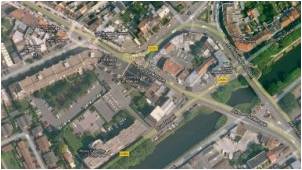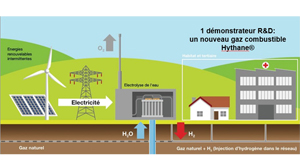ENGIE is trialing the injection of hydrogen into the natural gas distribution network of a new neighborhood, Le Petit village, and an NGV refueling station for buses located in the Dunkirk Urban Community. Heating and domestic hot water needs will be satisfied by an innovative energy solution: Hythane1, a new gas composed of hydrogen and natural gas. The aim of the project is to demonstrate the technical, economic, environmental and social advantages of this new energy solution for sustainable cities and green mobility in real operating situations.
The GRHYD demonstration project
The French government is supporting the GRHYD hydrogen energy storage demonstrator project now being conducted by ENGIE and a consortium of industrial partners2. France has set the target of meeting 23% of its gross end-user energy consumption from renewable sources by 2020. This ambitious project aims to convert surplus energy generated from renewable sources into hydrogen, which will then be blended with natural gas for a broad range of applications, including space heating, water heating and fuel. As a result, generators of energy from intermittent renewable sources, such as wind and solar power, will have a new solution for marketing the electricity they generate, at the same time as reducing greenhouse gas emissions.

The project was launched in 2014. The first two years were devoted to a phase of technical and sociological studies, followed by a five-year demonstration phase of two uses of hydrogen injection: transport and housing.
Development of hydrogen in this way delivers a direct response to a series of energy and environmental challenges…
- by helping to reduce greenhouse gas emissions
- by promoting regional industrial expertise and natural resources
- by supporting local economic development
- by preparing for the introduction of hydrogen-powered vehicles
To evaluate the technical, economic and environmental relevance of Power-to-Gas, two demonstrators for this new energy solution are now up-and-running as part of a project involving local authorities and local residents in the Dunkerque Urban Community:
- A transportation demonstrator
The industrial scale Hythane® fuel project. A VNG bus fueling station will be adapted to handle the hydrogen/natural gas blend, which will begin with a 6% hydrogen content that will be increased over time to 20%. A fleet of around 50 buses will be operated using this hydrogen-natural gas blend.
- A residential demonstrator
A new residential neighborhood of around 200 homes in the Capelle la Grande district of the Dunkerque Urban Community will be supplied with a blend of hydrogen and natural gas using a variable hydrogen content of below 20%. Production will be based on energy from renewable sources (wind power) injected into the power distribution network. Surplus power will be used to produce hydrogen for storage and subsequent distribution to meet demand.

Power to gas : The GRHYD demonstrator makes it possible to valorize the ENR (green electricity not finding an outlet on the electricity network) in the form of hydrogen gas distributed in the natural gas network, by implementing the Power-to-Gas concept.
The results of a simulation of the gas and hydrogen needs of the first 100 homes made it possible to determine what hydrogen installations would be required for electrolysis, storage and injection, and which models.
The proton exchange membrane (PEM) electrolyzer can produce up to 10 normal cubic meters of hydrogen per hour. The storage module has a capacity of 5 kg. The hydrogen is stored thanks to a technological innovation, in the form of metal hydrides.
The electrolyzer and storage technology have been tested in real operating situations to meet the energy demands of neighborhood residents.
Demonstration
Hydrogen converted back into gaseous form can be injected into the natural gas network to constitute a new fuel. The demonstration starts with the injection of the first molecules of hydrogen into the distribution network to supply homes in the new neighborhood.
The quantity of hydrogen mixed with the natural gas will vary depending on the availability of green electricity while remaining below 20% in volume in order to respect safety regulations.
Partners in the GRHYD project inaugurate France’s first Power-to-Gas demonstrator
KEY FIGURES
1 local authority committed (Cappelle-la-Grande, a small town in the Dunkirk Urban Community, pilot town)
3 hydrogen technologies tested: electrolysis, storage and the injection equipment
100 homes and the heating system of a clinic supplied by a new gas composed of hydrogen and natural gas during the demonstration
At completion: 200 homes including 120 houses and 80 apartments
1 Fuel composed of hydrogen and natural gas.
2 Twelve industrial partners are taking part in the GRHYD demonstration project alongside ENGIE. Companies include GrDF, GNVERT, AREVA Hydrogen and Energy Storage, CEA, McPhy Energy, INERIS, CETIAT and CETH2.

"POWER TO GAS": AN INNOVATIVE SOLUTION
